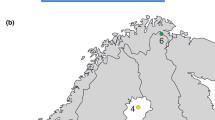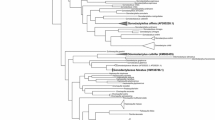Summary
-
1.
We examined the compound eyes of 2 species of gonodactyloid stomatopods, Gonodactylus oerstedii and Pseudosquilla ciliata, using end-on microspectrophotometry of frozen sections of dark-adapted retinas.
-
2.
The cornea and crystalline cones of both species were virtually transparent from 350 to 700 nm. Primary screening pigment granules in the retinular cells had the broad absorption spectra typical of ommochromes. Colored vesicles, of unknown function, also were found in the cytoplasm of the retinular cells. The intrarhabdomal filters appeared to act as long-pass spectral filters, and had maximum optical densities in situ of 0.94 to 11.1.
-
3.
A variety of visual pigments were found in both species, each in a specific retinal region. Their maximum absorption peaked at wavelengths from 400 nm to well beyond 530 nm.
-
4.
Spectral sensitivity functions of all retinal regions were estimated. In both species, each of the 4 most dorsal ommatidial rows of the central band had a pair of narrow spectral sensitivitity curves, usually separated by 50 to 75 nm. These 4 pairs covered the spectrum from below 400 to beyond 650 nm. The other 2 rows of the central band had identical, broad sensitivity functions. Spectral sensitivities of all peripheral ommatidia in each species were identical, but different from any region of the central band.
-
5.
These stomatopod species have retained the typical crustacean layered rhabdoms in the peripheral retina and the 2 most ventral rows of the central band, but have converted the photoreceptors of the 4 dorsal rows of the central band into as many as 8 narrowly tuned spectral classes. This design could serve a high-quality hue discrimination system.
Similar content being viewed by others
References
Arikawa K, Kawamata K, Suzuki T, Eguchi E (1987a) Daily changes of structure, function, and rhodopsin content in the compound eye of the crab Hemigrapsus sanguineus. J Comp Physiol A 161:161–174
Arikawa K, Inokuma K, Eguchi E (1987b) Pentachromatic visual system in a butterfly. Naturwissenschaften 74:297–298
Arnold K, Neumeyer C (1987) Wavelength discrimination in the turtle Pseudemys elegans. Vision Res 27:1501–1511
Barlow HB (1982) What causes trichromacy? A theoretical analysis using comb-filtered spectra. Vision Res 22:635–643
Bernard GD (1987) Spectral characterization of butterfly L-receptors using extended Dartnall/MacNichol template functions. J Opt Soc Am A4:P123
Bowmaker JK (1983) Trichromatic colour vision: why only three receptor channels? TINS 6:41–43
Bowmaker JK, Dartnall HJA, Herring PJ (1988) Longwave-sensitive visual pigments in some deep-sea fishes: segregation of ‘paired’ rhodopsins and porphyropsins. J Comp Physiol A 163:685–698
Bridges CDB (1972) The rhodopsin-porphyropsin visual system. In: Dartnall HJA (ed) Photochemistry of vision (Handbook of sensory physiology, vol VII/1). Springer, Berlin Heidelberg New York, pp 417–480
Bruno MS, Goldsmith TH (1974) Rhodopsin of the blue crab Callinectes sapidus: Evidence for absorption differences in vitro and in vivo. Vision Res 14:653–658
Bruno MS, Mote MI, Goldsmith TH (1973) Spectral absorption and sensitivity measurements in single ommatidia of the green crab, Carcinus. J Comp Physiol 82:151–163
Caldwell RL (1979) Cavity occupation and defensive behaviour in the stomatopod Gonodactylus festae: Evidence for chemically mediated individual recognition. Anim Behav 27:194–201
Caldwell RL (1985) A test of individual recognition in the stomatopod Gonodactylus festae. Anim Behav 33:101–106
Caldwell RL, Dingle H (1975) Ecology and evolution of agonistic behavior in stomatopods. Naturwissenschaften 62:214–222
Carlson SD, Philipson B (1972) Microspectrophotometry of the dioptric apparatus and compound rhabdom of the moth (Manduca sexta) eye. J Insect Physiol 18:1721–1731
Cronin TW (1985) The visual pigment of a stomatopod crustacean, Squilla empusa. J Comp Physiol A 156:679–687
Cronin TW (1986) Optical design and evolutionary adaptation in crustacean compound eyes. J Crust Biol 6:1–23
Cronin TW (1989) Application of intracellular optical techniques to the study of stomatopod crustacean vision. J Comp Physiol A 164:737–749
Cronin TW, Forward RB Jr (1988) The visual pigments of crabs I. Spectral properties. J Comp Physiol A 162:463–478
Cronin TW, Marshall NJ (1989) A retina with at least ten spectral types of photoreceptors in a mantis shrimp. Nature 339:137–140
Cronin TW, Nair JN, Doyle RD, Caldwell RL (1988) Ocular tracking of rapidly moving visual targets by stomatopod Crustacea. J Exp Biol 138:155–179
Cummins DR, Goldsmith TH (1981) Cellular identification of the violet receptor in the crayfish eye. J Comp Physiol 142:199–202
Dartnall HJA, Lythgoe JN (1965) The spectral clustering of visual pigments. Vision Res 5:81–100
Demoll R (1909) Über die Augen und die Augenstiel-Reflexe von Squilla mantis. Zool Jahrb, Abt Anat Ontog Tiere 27:171–212
Dingle H (1964) A colour polymorphism in Gonodactylus oerstedii Hansen, 1895 (Stomatopoda). Crustaceana 7:236–240
Dominguez JH, Reaka M (1988) Temporal activity patterns in reef-dwelling stomatopods: a test of alternative hypotheses. J Exp Mar Biol Ecol 117:47–69
Exner S (1891) Die Physiologie der facettirten Augen von Krebsen und Insecten. Deuticke, Leipzig Wien
Goldsmith TH (1978a) The effects of screening pigments on the spectral sensitivity of some Crustacea with scotopic (superposition) eyes. Vision Res 18:475–482
Goldsmith TH (1978b) The spectral absorption of crayfish rhabdoms: pigment, photoproduct and pH sensitivity. Vision Res 18:463–473
Goldsmith TH, Collins JS, Licht S (1984) The cone oil droplets of avian retinas. Vision Res 24:1661–1671
Goldsmith TH, Fernández HR (1968) Comparative studies of crustacean spectral sensitivity. Z Vergl Physiol 60:156–175
Govardovskii VI (1983) On the role of oil drops in colour vision. Vision Res 23:1739–1740
Hardie R (1985) Functional organization of the fly retina. In: Ottoson D (ed) Progress in sensory physiology 5. Springer, Berlin Heidelberg New York Tokyo, pp 1–79
Hardie RC (1988) The eye of the mantid shrimp. Nature 333:499–500
Hárosi FI (1985) Ultraviolet- and violet-absorbing vertebrate visual pigments: Dichoic and bleaching properties. In: Fein A, Levine JS (eds) The visual system. Alan R Liss, New York, pp 41–55
Hárosi FI, Hashimoto Y (1983) Ultraviolet visual pigment in a vertebrate: A tetrachromatic cone system in the dace. Science 222:1021–1023
Hays D, Goldsmith TH (1969) Microspectrophotometry of the visual pigment of the spider crab Libinia emarginata. Z Vergl Physiol 65:218–232
Killer-Adams P, Widder EA, Case JF (1988) The visual pigments of four deep-sea crustacean species. J Comp Physiol A 163:63–72
Horridge GE (1978) The separation of visual axes in apposition compound eyes. Phil Trans R Soc Lond B285:1–59
Hyatt GW (1975) Physiological and behavioral evidence for color discrimination by fiddler crabs (Brachyura, Ocypodidae, genus Uca) In: Vernberg FJ (ed) Physiological ecology of estuarine organisms. University of South Carolina Press, Columbia SC, pp 333–365
Labhart T (1988) Polarization-opponent interneurons in the insect visual system. Nature 331:435–437
Larrivee D, Goldsmith TH (1982) Spectral dimorphism of crayfish visual pigment in solution. Vision Res 22:727–737
Leggett LMW (1976) Polarised light-sensitive interneurones in a swimming crab. Nature 262:709–711
Lipetz LE, Cronin TW (1988) Application of an invariant spectral form to the visual pigments of crustaceans: implications regarding the binding of the chromophore. Vision Res 28:1083–1093
Ludolph C, Pagnanelli D, Mote MI (1973) Neural control of migration of proximal screening pigment by retinular cells of the swimming crab Callinectes sapidus. Biol Bull 145:159–170
MacNichol EF Jr (1986) A unifying presentation of photopigment spectra. Vision Res 26:1543–1556
Manning RB, Schiff H, Abbott BC (1984) Eye structure and the classification of stomatopod Crustacea. Zool Scripta 13:41–44
Mansfield RJW (1985) Primate photopigments and cone mechanisms. In: Fein A, Levine JS (eds) The visual system. Alan R. Liss, New York, pp 566–603
Marshall NJ (1988) A unique colour and polarisation vision system in mantis shrimps. Nature 333:557–560
Martin FG, Mote MI (1982) Color receptors in marine crustaceans: a second spectral class of retinular cell in the compound eyes of Callinectes and Carcinus. J Comp Physiol 145:549–554
McFarland WN, Munz FW (1975) The photic environment of clear tropical seas during the day. Vision Res 15:1063–1070
Ohtsuka T (1985a) Relation of spectral types to oil droplets in cones of turtle retina. Science 229:874–877
Ohtsuka T (1985b) Spectral sensitivities of seven morphological types of photoreceptors in the retina of the turtle, Geoclemys reevesii. J Comp Neurol 237:145–154
Sabra R, Glantz RM (1985) Polarization sensitivity of crayfish photoreceptors is correlated with their termination sites in the lamina ganglionaris. J Comp Physiol A 156:315–318
Schiff H, Abbott BC (1987) Shape, structure, and optics of the eyes of two lysiosquilloid stomatopods. J Crust Biol 7:158–170
Schiff H, Candone P (1986) Superposition and scattering of visual fields in a compound, double eye — II. Stimulation sequences for different distances in a stomatopod from a bright habitat. Comp Biochem Physiol 83A:445–455
Schiff H, Manning RB, Abbott BC (1986) Structure and optics of ommatidia from eyes of stomatopod crustaceans from different luminous habitats. Biol Bull 170:461–480
Schönenberger N (1977) The fine structure of the compound eye of Squilla mantis (Crustacea, Stomatopoda). Cell Tissue Res 176:205–233
Shaw SR, Stowe S (1982) Photoreception. In: Sandeman DC, Atwood HL (eds) The biology of Crustacea, vol 3. Academic Press, New York, pp 291–367
Sokal RR, Rohlf FJ (1969) Biometry. WH Freeman, San Francisco, p 776
Snyder AW, Menzel R, Laughlin SB (1973) Structure and function of the fused rhabdom. J Comp Physiol 87:99–135
Stavenga DG, Schwemer J (1984) Visual pigments of invertebrates. In: Ali MA (ed) Photoreception and vision in invertebrates. Plenum, Oxford New York, pp 11–61
Stowe S (1980) Spectral sensitivity and retinal pigment movement in the crab Leptograpsus variegatus (Fabricius). J Exp Biol 87:73–98
Trevino DL, Larimer JL (1969) The spectral sensitivity and flicker response of the eye of the stomatopod Squilla empusa Say. Comp Biochem Physiol 31:987–991
Waterman TH (1981) Polarization sensitivity. In: Autrum H (ed) Invertebrate visual centers and behavior I. (Handbook of sensory physiology, vol VII/6B). Springer, Berlin Heidelberg New York, pp 281–470
Waterman TH, Fernández HR, Goldsmith TH (1969) Dichroism of photosensitive pigment in rhabdoms of the crayfish Orconectes. J Gen Physiol 54:415–432
Yamaguchi T, Katagiri Y, Ochi K (1976) Polarized light responses from retinula cells and sustaining fibers of the mantis shrimp. Biol J Okayama Univ 17:61–66
Author information
Authors and Affiliations
Rights and permissions
About this article
Cite this article
Cronin, T.W., Marshall, N.J. Multiple spectral classes of photoreceptors in the retinas of gonodactyloid stomatopod crustaceans. J Comp Physiol A 166, 261–275 (1989). https://doi.org/10.1007/BF00193471
Accepted:
Issue Date:
DOI: https://doi.org/10.1007/BF00193471




